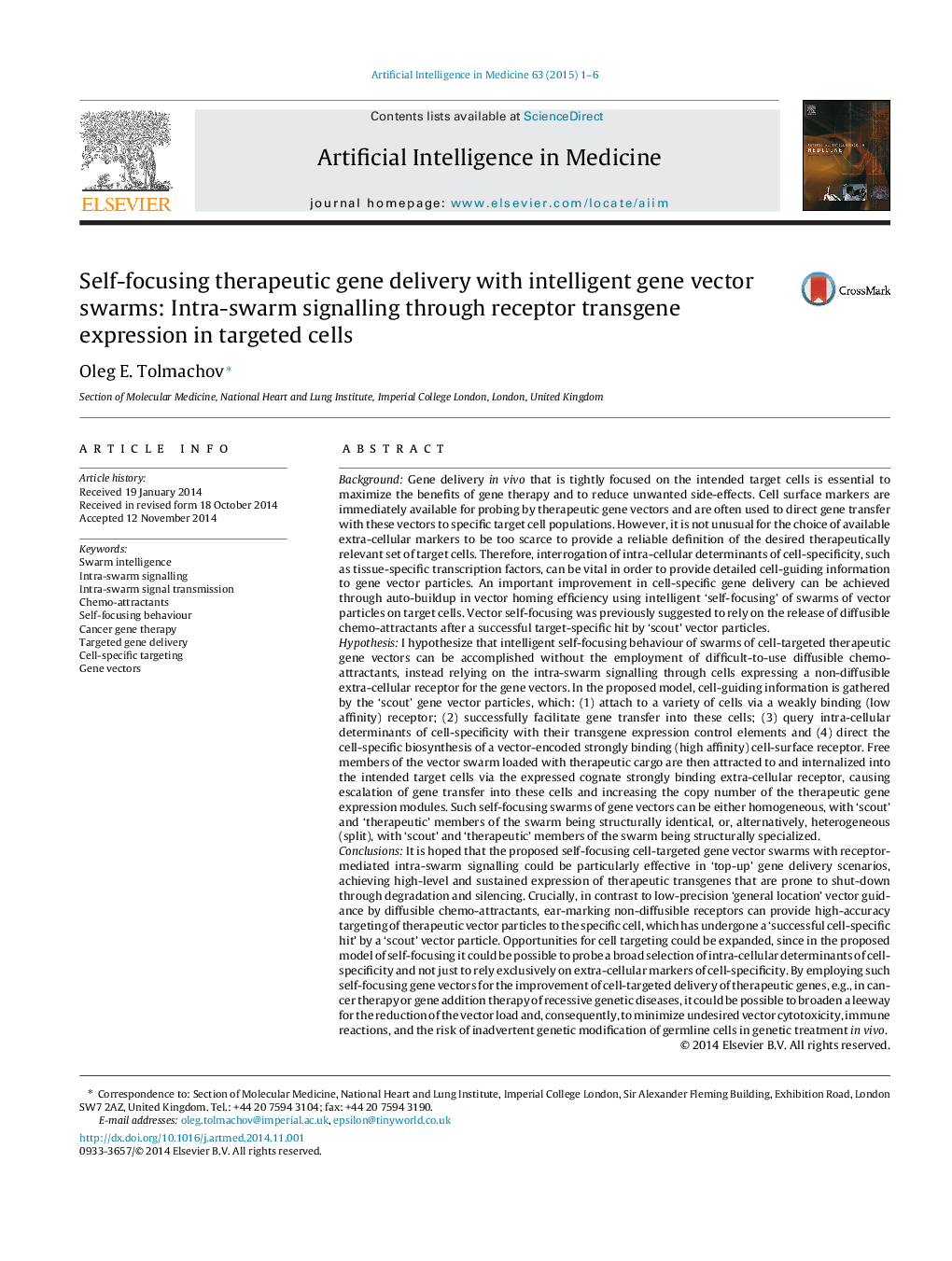| Article ID | Journal | Published Year | Pages | File Type |
|---|---|---|---|---|
| 377603 | Artificial Intelligence in Medicine | 2015 | 6 Pages |
BackgroundGene delivery in vivo that is tightly focused on the intended target cells is essential to maximize the benefits of gene therapy and to reduce unwanted side-effects. Cell surface markers are immediately available for probing by therapeutic gene vectors and are often used to direct gene transfer with these vectors to specific target cell populations. However, it is not unusual for the choice of available extra-cellular markers to be too scarce to provide a reliable definition of the desired therapeutically relevant set of target cells. Therefore, interrogation of intra-cellular determinants of cell-specificity, such as tissue-specific transcription factors, can be vital in order to provide detailed cell-guiding information to gene vector particles. An important improvement in cell-specific gene delivery can be achieved through auto-buildup in vector homing efficiency using intelligent ‘self-focusing’ of swarms of vector particles on target cells. Vector self-focusing was previously suggested to rely on the release of diffusible chemo-attractants after a successful target-specific hit by ‘scout’ vector particles.HypothesisI hypothesize that intelligent self-focusing behaviour of swarms of cell-targeted therapeutic gene vectors can be accomplished without the employment of difficult-to-use diffusible chemo-attractants, instead relying on the intra-swarm signalling through cells expressing a non-diffusible extra-cellular receptor for the gene vectors. In the proposed model, cell-guiding information is gathered by the ‘scout’ gene vector particles, which: (1) attach to a variety of cells via a weakly binding (low affinity) receptor; (2) successfully facilitate gene transfer into these cells; (3) query intra-cellular determinants of cell-specificity with their transgene expression control elements and (4) direct the cell-specific biosynthesis of a vector-encoded strongly binding (high affinity) cell-surface receptor. Free members of the vector swarm loaded with therapeutic cargo are then attracted to and internalized into the intended target cells via the expressed cognate strongly binding extra-cellular receptor, causing escalation of gene transfer into these cells and increasing the copy number of the therapeutic gene expression modules. Such self-focusing swarms of gene vectors can be either homogeneous, with ‘scout’ and ‘therapeutic’ members of the swarm being structurally identical, or, alternatively, heterogeneous (split), with ‘scout’ and ‘therapeutic’ members of the swarm being structurally specialized.ConclusionsIt is hoped that the proposed self-focusing cell-targeted gene vector swarms with receptor-mediated intra-swarm signalling could be particularly effective in ‘top-up’ gene delivery scenarios, achieving high-level and sustained expression of therapeutic transgenes that are prone to shut-down through degradation and silencing. Crucially, in contrast to low-precision ‘general location’ vector guidance by diffusible chemo-attractants, ear-marking non-diffusible receptors can provide high-accuracy targeting of therapeutic vector particles to the specific cell, which has undergone a ‘successful cell-specific hit’ by a ‘scout’ vector particle. Opportunities for cell targeting could be expanded, since in the proposed model of self-focusing it could be possible to probe a broad selection of intra-cellular determinants of cell-specificity and not just to rely exclusively on extra-cellular markers of cell-specificity. By employing such self-focusing gene vectors for the improvement of cell-targeted delivery of therapeutic genes, e.g., in cancer therapy or gene addition therapy of recessive genetic diseases, it could be possible to broaden a leeway for the reduction of the vector load and, consequently, to minimize undesired vector cytotoxicity, immune reactions, and the risk of inadvertent genetic modification of germline cells in genetic treatment in vivo.
